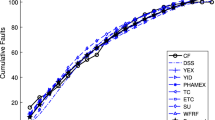Abstract
In any manufacturing environment, the fault introduction rate might be considered one of the most meaningful criterion to evaluate the goodness of the development process. In many investigations, the estimates of such a rate are often oversimplified or misunderstood generating unrealistic expectations on the prediction power of regression models with a fault criterion. The computation of fault introduction rates in software development requires accurate and consistent measurement, which translates into demanding parallel efforts for the development organization. This paper presents the techniques and mechanisms that can be implemented in a software development organization to provide a consistent method of anticipating fault content and structural evolution across multiple projects over time. The initial estimates of fault introduction rates can serve as a baseline against which future projects can be compared to determine whether progress is being made in reducing the fault introduction rate, and to identify those development techniques that seem to provide the greatest reduction.
Similar content being viewed by others
References
Chillarege, R., Bhandari, I., Chaar, J., Halliday, M., Moebus, D., Ray, B., and Wong, M. Y. 1992. Orthogonal defect classification—A concept for in-process measurement. IEEE Transactions on Software Engineering 18(11): 943–946.
Elbaum, S. G., and Munson, J. C. 1998. A standard for the measurement of C complexity attributes. Technical report: TR-CS–98–02, Software Engineering Testing Lab, University of Idaho.
Elbaum, S. G., and Munson, J. C. 1998. Code churn: A measure for estimating the impact of code change. Proceedings of the International Conference on Software Maintenance, 24–31.
Fenton, N. E. 1994. Software measurement: A necessary scientific basis. IEEE Transactions in Software Engineering 20(3): 199–206.
IEEE Standard Dictionary of Measures to Produce Reliable Software. 1989. IEEE Std. 982.1. Institute of Electrical and Electronics Engineers.
IEEE Standard Classification for Software Anomalies. 1993. IEEE Std. 1044. Institute of Electrical and Electronics Engineers.
Khoshgoftaar, T. M., and Munson, J. C. 1990. Predicting software development errors using complexity metrics. Journal on Selected Areas in Communications 8: 253–261.
Khoshgoftaar, T. M., and Munson, J. C. 1992. A measure of software system complexity and its relationship to faults. Proceedings of the International Simulation Technology Conference San Diego, CA, 267–272.
Luqi. 1990. A graph mode for software evolution. IEEE Transactions on Software Engineering 16(8): 917–920.
Munson, J. C., and Khoshgoftaar, T.M. 1990. Regression modeling of software quality: An empirical investigation. Journal of Information and Software Technology 32: 105–114.
Munson, J. C., and Khoshgoftaar, T. M. 1990. The relative software complexity metric: A validation study. Proceedings of the Software Engineering Conference. Cambridge, UK, 89–102.
Munson, J. C., and Khoshgoftaar, T. M. 1992. The detection of fault-prone programs. IEEE Transactions on Software Engineering 18(5): 423–433.
Munson, J. C. 1995. Software measurement: problems and practice. Annals of Software Engineering J. C. Baltzer AG, (1): 255–285.
Munson, J. C. 1996. Software faults, software failures, and software reliability modeling. Information and Software Technology N38: 687–699.
Munson, J. C., and Werries, D. S. 1996. Measuring software evolution. Proceedings of the 1996 IEEE International Software Metrics Symposium, Berlin, Germany, 41–51.
Musa, J. 1989. Faults, failures and a metrics revolution. IEEE Software 6(2): 85–91.
Nikora, A. P. 1998. Software system defect content prediction from development process and product characteristics. Doctoral dissertation, Department of Computer Science, University of Southern California.
Nikora, A. P., Schneidewind, N. F., Munson, J. C. 1997. V&V issues in achieving high reliability and safety in critical control system software. Proceedings of the International Society of Science and Applied Technological Conference, Anaheim, California, 25–30.
Nikora, A. P., and Munson, J. C 1998. Software evolution and the fault process. Proceedings of the twenty third annual software engineering workshop, NASA/Goddard Space Flight Center (GSFC) Software Engineering Laboratory (SEL).
Nikora, A. P., Munson, J. C. 1998. Determining fault insertion rates for evolving software systems. Proceedings of the 1998 IEEE International Symposium of Software Reliability Engineering, Paderborn, Germany, IEEE Computer Society Press.
Author information
Authors and Affiliations
Rights and permissions
About this article
Cite this article
Elbaum, S.G., Munson, J.C. Software Evolution and the Code Fault Introduction Process. Empirical Software Engineering 4, 241–262 (1999). https://doi.org/10.1023/A:1009830727593
Issue Date:
DOI: https://doi.org/10.1023/A:1009830727593




